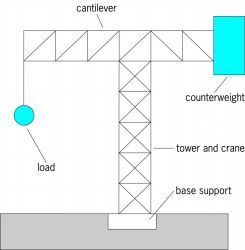cantilever
Cantilever

cantilever
[′kant·əl‚ē·vər]Cantilever
A linear structural member supported both transversely and rotationally at one end only; the other end of the member is free to deflect and rotate. Cantilevers are common throughout nature and engineered structures; examples are a bird's wing, an airplane wing, a roof overhang, and a balcony. See Wing
A horizontal cantilever must be counterbalanced at its one support against rotation. This requirement is simply achieved in the design of a playground seesaw, with its double-balanced cantilever. This principle of counterbalancing the cantilever is part of the basic design of a crane, such as a tower crane (see illustration). More commonly, horizontal cantilevers are resisted by being continuous with a backup span that is supported at both ends. This design is common for cantilever bridges; all swing bridges or drawbridges are cantilevers. See Bridge
Vertical cantilevers primarily resist lateral wind loads and horizontal loads created by earthquakes. Common vertical cantilevers are chimneys, stacks, masts, flagpoles, lampposts, and railings or fences. All skyscrapers are vertical cantilevers. One common system to provide the strength to resist lateral loads acting on the skyscraper is the use of a truss (known as bracing). See Buildings, Shear, Truss
Some of the largest cantilevers are used in the roofs of airplane hangars. It has become common practice to include cantilevers in the design of theaters and stadiums, where an unobstructed view is desired; balconies and tiers are supported in the back and cantilevered out toward the stage or playing field so that the audience has column-free viewing. See Beam, Roof construction
cantilever

cantilever

Cantilever
a structure (for example, a girder or a truss) with one end that is stably secured and another that is free; it can also be a part of a structure extending beyond the support. A cantilever is generally used when the installation of additional supports is impossible or inadvisable (for example, the supporting structure of a balcony or ledge). An outrigger is a form of cantilever. A distinctive feature of a cantilever is that determination of load stresses does not require preliminary calculation of bearing pressures but examination of the conditions of equilibrium of the free part of the cantilever.
Cantilever
an overhanging support element or structure used to attach parts of machines or structures to a vertical wall or column. Structurally, cantilevers are made as an independent part with a diagonal strut or as a considerably thickened portion of the basic element.
Cantilevers are usually used for the installation of bearings, individual machine assemblies, and equipment on transmission towers and supports. In architecture, which uses ordered elements, a cantilever, or corbel, is usually a projection from within a wall, which is often shaped (with decorative scrolls, volutes, or other ornamentations). The cantilever is used for supporting balconies or greatly protruding cornices.
